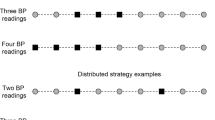Abstract
Determining blood pressure (BP) values at different daily time periods is a well recognised measure to assess the risk of end-organ damage. However, the use of various definitions of these periods, eg, day vs night, sleep vs wake or arbitrary definitions, makes clinical decisions based on available data difficult. In the present study, we compared BP loads in actual sleep–wake periods to default day–night definition provided by the ambulatory BP monitoring (ABPM) software (day 06.00–22.00; night 22.00–06.00) as well as to an arbitrary definition of sleep–wake periods in children published in Journal of Pediatrics (Soergel et al, 1997) (awake 08.00–20:00 and sleep 00.00–06.00). We used an actigraph, an accelerometer, to define the actual sleep–wake periods in 46 patients with essential hypertension who are on various treatment regimens. BP data were obtained by using Spacelabs 90207 monitors for a full 24 hours. There were significant differences between actual sleep–wake and default definition for BP load. No similar findings were noted when arbitrary definition was used. The proportion of hypertensives was not significantly different when default and arbitrary definitions were used. Classification of dippers and non-dippers is greatly affected by the definition of sleep interval using the default method. Although some of the misclassifications were not statistically significant, their clinical importance must be considered. Determination of sleep and wake periods for analysis of ABPM data should be based on careful determination of actual periods. Using other definitions may not provide complete information or accommodate for individual variation.
This is a preview of subscription content, access via your institution
Access options
Subscribe to this journal
Receive 12 digital issues and online access to articles
$119.00 per year
only $9.92 per issue
Buy this article
- Purchase on Springer Link
- Instant access to full article PDF
Prices may be subject to local taxes which are calculated during checkout
Similar content being viewed by others
Author information
Authors and Affiliations
Rights and permissions
About this article
Cite this article
Eissa, M., Yetman, R., Poffenbarger, T. et al. Comparison of arbitrary definitions of circadian time periods with those determined by wrist actigraphy in analysis of ABPM data. J Hum Hypertens 13, 449–453 (1999). https://doi.org/10.1038/sj.jhh.1000849
Received:
Accepted:
Published:
Issue Date:
DOI: https://doi.org/10.1038/sj.jhh.1000849
Keywords
This article is cited by
-
On the use of actigraphy in clinical evaluation of diurnal blood pressure profile
Somnologie (2020)
-
Recognition of activities in children by two uniaxial accelerometers in free-living conditions
European Journal of Applied Physiology (2011)



